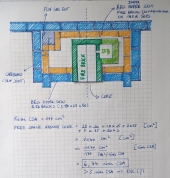posted 7 years ago
I haven't played around with refractory mortar. I have used castables, though. My thoughts, after seeing the cracking in the first part of the video, are around the difference in expansion between the firebricks and mortar, and how that movement appears to be overcoming the adhesion. As Duane mentioned, these products have precise mixing and application instructions along with initial firing tolerances. They're really pretty touchy. The temperature profile experienced in firing the batch box probably ramps up too fast, and most likely has hot and cool spots instead of an even gradient pattern.
You might want to try a simple fireclay slip mortar with sodium silicate. This will be a lot more plastic than the refractory product and may be more forgiving of the erratic heating of a wood fire. If you get it nice and hot, the clay and silicate will flow a bit. Also, you might have to accept some shifting around as the nature of the beast and count on the wrapping to keep everything in place. I'd try laying bricks across the top, or if that simply won't work get a bag of castable, make a top using a form and then mortar it in place.








